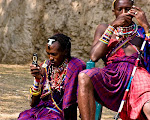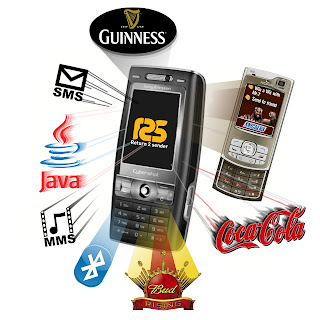Business Opportunity:
The possibilities of “virtual” packaging have no limits. It provides a solution to:
Consumer demand for additional information
Limited space on packaging
Static nature of pack information
Basic Scenario
At its most basic extended packaging is simply about providing additional product information. A consumer scans a bar code on product with their mobile phone. He connects to a network and retrieves additional information about the product.
However, when a person predefines what information they are interested in, this application can become extremely powerful for both business and consumers. Information that is shared with consumers becomes more valuable because it is personalized and relevant to consumer needs.
This vision of extended packaging gives businesses the opportunity to enter into dialogue with their consumers where information is exchanged on both sides and where both sides benefit.
Business Benefit:
l Richer and more complete shopper behavior data allows better decision-making and sharper campaigns
l Better service to customers
l Differentiate from competitors
l Increased trust in brand through transparency
l Helps on-the-post purchase decision
l Wider audience
l Up-to-date information
l Easier internationalization of products
l Cross-selling
Consumer Benefits
l Control over information received
l Right information at the right time in the right format
l Information available anywhere, anytime, on any product
l Personalized information (profiling)
l Easier to use for consumers



1. Before shopping:
The consumer downloads the
CodeOnLine application and defines
the information she is interested in
2. In-store 1:
The consumer opens
CodeOnLine application and takes
a picture of the bar code on the
product she is interested in
3. In-store:
A few seconds later, she receives
the required information about the
product on her mobile phone
Data Carrier
An identification key can be represented physically in the form of the bar code. Both one-dimensional (1D) and two-dimensional (2D) bar codes exist. 1D bar codes (also called linear bar codes) are one of the most widespread and well-known global identification applications and can be seen anywhere in the world. Standards for 1D bar codes have been developed and adopted since the early 1970’s. 1D bar codes are read by laser-based scanners (currently at point-of-sale and throughout the supply chain) and camera-based readers (by mobile phones and in specific environments).
1D bar codes require that the size and printing quality match certain criteria in order to be compliant with the standards. 2D bar codes are more novel and have become commonplace in countries with faster adoption of more advanced mobile phones and networks, such as Japan and Korea. There is still relatively little standardization and many divergent implementations and varieties exist. Several vendors are trying to use this situation to their advantage creating private or patented solutions.
2D bar codes are more advanced than 1D bar codes and have built-in error-correction mechanisms that accept some considerable tolerances in the quality of the printed image without any reduced performance in scanning and recognition of the symbol. 2D bar codes require camera-based scanners to be read. 2D bar codes found in Asia are standardized but proprietary (with non-claimed royalty rights) and allow a URL (web address) to be encoded.
Mobile devices present a very good technical opportunity to act as bar code scanners to capture information stored in 1D or 2D bar codes printed on the product packaging and in other locations.
Common in Japan, where it was created by Toyota subsidiary Denso-Wave in 1994, the QR code is one of the most popular types of two-dimensional barcodes. QR is the abbreviation for Quick Response, as the creator intended the code to allow its contents to be decoded at high speed.
Another radical and exciting advancement in barcode reader technology allowed the camera in a mobile phone to act as a reader. Mobile phones can now be enabled to read a variety of 2D mobile barcodes. These include QR codes, Data Matrix, Cool-Data-Matrix, Aztec, Upcode, Trillcode, Quickmark, shotcode, mCode and Beetagg.
The vast majority of symbologies are in the public domain, which means they can be used by anyone without restriction and without payment of a fee or royalty. This public approach gives rise to internationally recognised standards, global interoperability, and creates an economy of scale. This is a great boon for advertisers and consumers (both of whom are the mobile operators’ customers) because only one software client is required to read any code. For the operators, this translates to greater choice and more competitively priced equipment.
Unfortunately, some barcode developers have chosen the proprietary route, which means they keep control of their own codes, the information that is permitted to be encoded and charge a fee or royalty for their use. These issues and the lack of interoperability usually means that proprietary barcodes tend to be used in controlled, closed environments, rather than in open, public systems around the world.The most common use of mobile barcodes is to request information or a service or content from a Web site. It might be details of a promotion, or a discount voucher via SMS or MMS, or to activate a download such as a ringtone, music track or game, or click to call an IVR or human agent, or buy a travel or concert ticket. The advertiser pays the set-up costs as well as its operator partner on a per-click, download, view, redeemed coupon, ticket sale or call, depending on the campaign.
The key is that mobile barcodes are a pull technology, a permission-based way for a consumer to engage with an advertiser or medium. This is a very important attribute since there is a great deal of consumer angst and regulatory concern about intrusive mobile marketing: mobile barcodes are a world away from pushing unsolicited spam via SMS or MMS. Big brands are understandably wary of engaging in any advertising activity that compromises their reputation by alienating their customers and have stayed away from these kinds of push campaigns.
The pull of mobile barcodes overcome these issues and offer a direct, accountable way of connecting with consumers. However, if mobile barcodes are to succeed as an advertising medium, a high level of back-office integration is necessary, which reinforces the importance of open standards for processes and interfaces. Operators will need to demonstrate to the world’s biggest brands that the barcode scanning transactions are accurate, reliable and defendable because they are going to charge that brand for every click.
The precedent is there: Google has built a multi-billion dollar, online business on this per click or interaction model with its Google AdWord/AdSense, which provides advertisers with reliable, accountable records of their users’ transaction history and an accurate invoice, plus timely and granular revenue share payments to other parts of the ecosystem. In mobile, unlike online, there is the additional challenge that these mechanisms have to work across carriers, across countries and across currencies.
So the stage is set. With 2D barcode scanning, advertisers have a reliable, permission-based mobile channel open to them. Consumers love them as an easy way of using mobile technology to engage with services and media they are interested in, as has been demonstrated in spades in Japan, where mobile barcodes are part of everyday life. This is because Japan is unusual in having a very dominant operator, NTT DoCoMo, which decided to endorse QR codes and ensured that all new handsets had QR code client software embedded in them. The rest is history, but this approach is not applicable to markets in most other countries, which typically have four or five operators competing against each other.
The challenge now is to ensure that any brand advertiser can run the same ad campaign in Singapore, London and Seattle instead of having to produce and run different campaigns in each country and for every operator. The inability to do this has been another big inhibitor to mobile advertising. Mobile barcodes have the potential to overcome these issues and become the mainstream, global phenomenon that they could and should be. However to attain this goal, the various parties that make up the ecosystem and the various warring factions within the mobile barcode industry need to come together and work on common standards* that will be to everyone’s advantage.




















